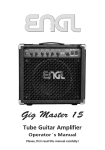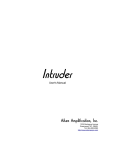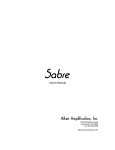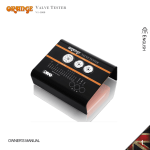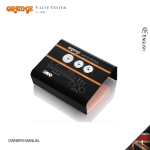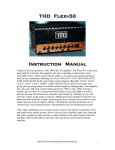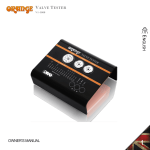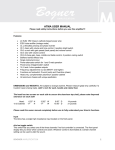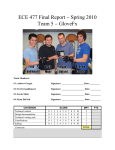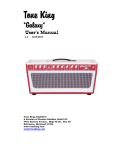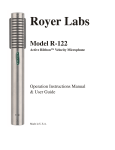Download Tomcat - Aiken Amplification
Transcript
Tomcat User's Manual Aiken Amplification, Inc. 1225 Montague Avenue Greenwood, SC 29649 Tel: 864-993-8383 http://www.aikenamps.com Contents Contents...............................................................................................................2 Getting Started.....................................................................................................3 Front Panel Controls and Switches...................................................................5 Rear Panel Controls and Switches....................................................................7 Footswitch ...........................................................................................................8 Tube layout and replacement.............................................................................9 Biasing................................................................................................................10 Speakers.............................................................................................................11 Troubleshooting................................................................................................12 Specifications....................................................................................................14 TomcatMKIIManual.doc 12/08/11 Copyright 2003-2011, Aiken Amplification, Inc. Page 2 of 14 Getting Started Congratulations on purchasing your new Aiken Tomcat amplifier! The Tomcat is a push-pull, cathode-biased, no-negative feedback amplifier featuring two EL84 tubes in the output stage. The deceptively simple, yet highly effective controls include Volume, Tone, an AC-30style Cut control, and our very transparent built-in attenuator, which features a Variable control that is enabled at the last setting to take the volume down to “bedroom” levels. The design features a single channel “nofrills” signal path for the utmost in harmonic complexity. It is specifically designed to be very reactive to the speaker cabinet it is connected to, giving wide variations in tone with different speakers. The amplifier was designed specifically to capture the typical “class A” cathode-biased, non-negative feedback tone at lower volumes, with the addition of an “over-thetop” footswitchable gain boost for soloing. Features include: All-tube signal path. The preamp tube is an ECC81/12AT7, the phase inverter is ECC83/ 12AX7, Output tubes are EL84. The rectifier uses massive 3 amp 1000V ultra-fast recovery diodes (UFREDs) for the utmost reliability and a tight, fat low end. Front panel controls/connections: Input jack, Volume, Tone, Cut, Attenuator, and Variable. There is also a bright switch and a gain switch, which is footswitch controllable. Rear panel controls/connections: AC mains input, international voltage selector allowing operation at 100V/120V/200V/220V/230V/240V 50/60Hz, impedance selector switch for 4, 8, or 16 ohm operation, two 1/4" speaker jacks, and a gain footswitch jack. Solid, finger-jointed birch-ply cabinet. The head is 20" wide, 8 3/4" tall, and 9" deep, the combo is 25” wide, 18 ½” tall, and 10 ¼” deep. Solid 16-gauge steel chassis, zinc-plated, yellow chromate conversion coated for durability, corrosion-resistance and appearance. Front and rear faceplates are gold anodized aluminum for durability and a classic appearance. All hand-wired, “military style” turret-board construction (no PC boards), using chassismounted tube sockets for ease of maintenance and reliability. Built to last. Premium, tight-tolerance parts are used for reliability, including 2W 1% carbon film and metal film resistors, 5W metal oxide power resistors, 630V axial-leaded polypropylene film/foil capacitors, and low-noise, sealed, 2W mil-style RV4 pots. TomcatMKIIManual.doc 12/08/11 Copyright 2003-2011, Aiken Amplification, Inc. Page 3 of 14 Massive, custom-wound, high-interleave transformers, rated for over twice the maximum amplifier output power, allowing the amplifier to be run full power into an attenuator continuously, without failures. Output power (at onset of clipping): 12W. Built-in power attenuator with 0dB, -3dB, -6dB, -9dB, -12dB positions, as well as a VAR position that enables a second continuously-variable control that goes from –15dB down to “bedroom” levels for low volume recording, or apartment/bedroom volume practicing. Perfect for studio or club use. This is actually a true attenuator, working between the output transformer and speakers, functionally similar to some of the current attenuators on the market, but a completely unique design that doesn’t lose highs or lows as you attenuate the signal. TomcatMKIIManual.doc 12/08/11 Copyright 2003-2011, Aiken Amplification, Inc. Page 4 of 14 Front Panel Controls and Switches Input jack: Plug your guitar in here and you are ready to rock! Bright switch: This switch, when enabled in the “up” position, make the amp brighter for a more “shimmery” treble response. Gain switch: This switch, when enabled in the “up” position, gives the amp approximately a 10dB gain boost, which drives it into the smooth, singing distortion range. This switch can also be remotely activated using the rear panel footswitch jack, so it can be used as a boost for solos. Note that the front panel switch will override the footswitch, so if the footswitch is to be used, the front panel switch should be left in the “up” position. Volume: The volume control adjusts the overall level and amount of gain the amplifier has. For cleaner tones, set the volume lower, for more drive and distortion, set the volume higher. When used in conjunction with the attenuator, the amplifier can be set for any desired amount of clean or distortion tone. Tone: The tone control adjusts the ratio of high frequency to low frequency equalization. the clockwise end of rotation, the tone is bright and at the other end the tone is dark. At Cut: The cut control rolls of the highs after the phase inverter, giving a darker, smoother tone. TomcatMKIIManual.doc 12/08/11 Copyright 2003-2011, Aiken Amplification, Inc. Page 5 of 14 Attenuator: The attenuator controls the overall output level, and allows turning the amplifier up to get full-volume overdrive tones at lower volumes, without sacrificing tone quality. This approach avoids the "buzzy" sound characteristic of master volume amplifiers. The attenuator features 0dB, -3dB, -6dB, -9dB, and -12dB positions, as well as a VAR position which enables a second, continuously-variable control that goes from –15dB down to “bedroom” levels for low volume recording or bedroom/apartment practicing. It is okay to switch the attenuator to different settings with the amplifier on, but it is recommended to not be playing while changing positions, because a rotary switch, such as that used in the attenuator, will have a small fractional amount of time where there is no connection at all during the switching process. While we have never seen an output transformer or tube damaged by this, it is remotely possible that the transient may cause a problem, so it is not recommended. Before changing positions, just stop playing for a second, change to the different attenuation level, and continue playing. Variable: This control is only enabled when the attenuator is set to the “VAR” position. It allows adjustment from –15dB down to very low “bedroom” levels to allow quiet practicing or recording. Pilot lamp: The pilot lamp lights when power is applied to the amplifier and the power switch is on. The pilot lamp features a screw-on “jewel” that can be removed from the front panel to replace the bulb without having to remove the chassis. The bulb is a standard #47 “bayonet” style bulb, available at most electronics supply stores. Power switch: The Power switch turns the amplifier on in the up position and off in the down position. Glory switch: What good is power without the glory? The Glory switch allows muting of the amplifier output when not in use. When the switch is in the up position, the amplifier is on, and when it is in the down position, the amplifier is on standby. The tube filaments remain on and warmed up, so the amplifier is ready to play as soon as it is taken off standby. The correct powerup sequence is to turn the amplifier on with the power switch and then, after it has had time to warm up, the Glory switch is turned on. When turning the amplifier off, the Glory switch should first be turned off, then the power is turned off after a few seconds. TomcatMKIIManual.doc 12/08/11 Copyright 2003-2011, Aiken Amplification, Inc. Page 6 of 14 Rear Panel Controls and Switches AC Mains: Plug the supplied IEC mains cord into this outlet to provide power to the amplifier. Mains Fuse: 2A slo-blo for 100V/120V operation, 1A slo-blo for 200V-240V operation. AC Mains voltage selector: Set this switch to the appropriate position to match the mains voltage in the country in which you are using the amplifier. WARNING: Do not adjust this control with the AC mains cord plugged in and the power on!!! Damage to the amplifier will result if the switch is set to the wrong position. If you have any doubts as to which is the correct voltage for the country you are in, call the factory or inquire with someone locally who will know the correct mains voltage. HT Fuse: 500mA fast-acting fuse Impedance Selector: The impedance selector allows selection of 4, 8, or 16 ohm output impedance to match the speaker in use. Be sure to set this switch to the appropriate setting for the speaker or speakers connected to the amplifier. Speaker Jacks: Two speaker jacks are provided to allow use of the amplifier with up to two external speaker cabinets. More than two external cabinets may be safely used with the amplifier, but this will require the use of "Y" cables for the extra two cabinet connections. Be sure to use only quality speaker cable - do NOT, under any circumstance, use guitar cable to connect the amplifier to a speaker cabinet. Doing so may cause damage to the amplifier. Footswitch: This jack allows connection of any standard footswitch to remotely turn on the gain boost on and off. A footswitch is not included with the amplifier. It can be ordered from us, or you can build your own using the information shown in the next section of this manual. TomcatMKIIManual.doc 12/08/11 Copyright 2003-2011, Aiken Amplification, Inc. Page 7 of 14 Footswitch Since a boost footswitch is not included with the amplifier, some may prefer to make their own, or use an existing footswitch rather than purchase one. Any standard footswitch that shorts the tip to the sleeve of the ¼ jack will work. A good one is the Cliff FCR6918P (no LED, but one can be added as shown below). It is available from Musician’s Friend (http://www.musiciansfriend.com) or other online stores. If you desire a visual indication of boost “on” status, an LED may be added by simply connecting it across the contacts of the switch, with the cathode of the LED going to the sleeve connection of the jack as shown in the schematic below: A good LED to use is the CML 5100H1 (Digikey part number L10001-ND, available from http://www.digikey.com . Later models require a 220 ohm resistor in series with the LED as shown in the second diagram below. Earlier models (up to 0028, possibly 0029-0032, check with factory): Later models (serial numbers 0033 and higher, possibly 0029-0032, check with factory): TomcatMKIIManual.doc 12/08/11 Copyright 2003-2011, Aiken Amplification, Inc. Page 8 of 14 Tube layout and replacement The Tomcat uses one ECC81/12AT7 preamp tube, one ECC83/12AX7 phase inverter tube, and two 6BQ5/EL84 output tubes. The preamp tubes are housed in removable "bayonet" metal shields. The shields can be removed by pushing down on them and rotating the shield to the left, then pulling it upwards off the tube. The tube can then be pulled out of the socket. The output tubes have spring wire retainers that can be slipped off to one side, allowing easy removal of the EL84 tubes. The tube complement is as follows, starting at the side closest to the input jack: preamp (ECC81/12AT7), phase inverter (ECC83/12AX7), output tube 1, output tube 2. The chassis top view layout is shown in the diagram above. You may freely sub any 12xxx type tube in the two preamp and phase inverter positions. It won't hurt anything, and you may find some different tones you like. The 12AU7 is a good lower-gain tube for the first position, as is the 5751. Other choices are 12AY7, 12AT7, or 12AZ7. In addition, different manufacturer's tubes will sound different. Some people prefer the tone of various Ei, Sovtek, or other tubes, and some insist on NOS tubes for a true vintage tone. Feel free to experiment! Note: vacuum tubes, especially output tubes, can get very hot in normal operation, and may cause burns if removed before they have a chance to cool down. Be sure to wait several minutes before replacing tubes to allow them to cool down. Do not, under any circumstances, remove or replace the tubes with the power on, as this could cause a deadly electrical shock should the glass break, exposing the high-voltage plate terminals. Also, be sure to pay attention to the orientation of the tubes when putting them back in the socket. The tube pinout is keyed so it can only be placed in the socket in one direction, and if the tube is forced in incorrectly, it can damage the tube or the ceramic socket. TomcatMKIIManual.doc 12/08/11 Copyright 2003-2011, Aiken Amplification, Inc. Page 9 of 14 Biasing This amplifier is cathode biased (no adjustments necessary), and is designed to run at rather conservative voltages and currents, so you should be able to just plug in a new set of tubes and play, without worrying about whether the tubes are biased correctly. In rare occasions, a tube or pair of tubes may be so far out of the normal specified range that they will not work properly with the amplifier. This should be immediately apparent when playing the amplifier, as the volume and tone will be very weak or mushy. Note: If a tube is biased too hot, the plate will glow a dull red color. The plate is the large grey metal "box" structure seen inside the tube. Don't confuse normal filament glow with plate glow. Plate glow can usually be seen as a "hot spot" near the center of the plate, sometimes accompanied by a "hot" smell and some "ticking" noises as the metal expands. Continued operation with glowing plates will soon result in failure of the tubes, possibly damaging screen grid resistors or other amplifier components. The HT fuse should prevent any major damage to output or power transformers, or other expensive components. TomcatMKIIManual.doc 12/08/11 Copyright 2003-2011, Aiken Amplification, Inc. Page 10 of 14 Speakers Changing speakers is like getting a whole new amp. Every model sounds completely different, some sounding quite good and some amazingly bad. The Aiken A12 speaker is a custom made speaker using British cones, designed to meet our exacting tonal requirements. The amplifier is also particularly well suited for use with Celestion loudspeakers, which give the characteristic Voxy "British" sound this amplifier is designed to create. Celestion Greenbacks have less volume and a dip in the mids, which makes them nice and smooth. They are rated at 25W, so they make a nice match for the Tomcat. Celestion Alnico Blues are by far the loudest, with a nice chimey top end (but not extremely cutting highs) and full bottom end, but their rather pronounced midrange and very low power rating (15W) may make them undesirable for some users. Jensen P12B "bell" alnico's are far brighter than the Celestion Alnico Blue, but don't have as good a low-end response. They can, however, sound very nice when paired with the Alnico Blue in a 2x12 configuration. Celestion Vintage 30's have a very pronounced midrange, which may be a bit too harsh in an open-back configuration, which naturally enhances the midrange frequencies, and can sound a bit "boxy" with the wrong speaker. They do sound good for some blues styles, and can easily handle the power of the Tomcat. Celestion G12H30's are like a cross between the Greenback and the Vintage 30, with more low end than the Vintage 30 and not quite as pronounced a midrange, so they tend to sound subjectively "better" in an open-back cabinet. Closed-back cabinets have better and tighter bass, without the pronounced midrange hump of the open-backs, but they don't disperse on stage as well, and tend to be "beamy", sounding very loud out front, but if you stand above and to the front or back, you can't hear yourself as well. Still, there is nothing quite like the tone of a cranked up 4x12 cabinet loaded with Greenbacks! For a more portable closed back, a 2x12 loaded with either of those Celestions will do the trick nicely. Putting a 2x12 on each side of the stage fills up the tone very well, and provides an almost stereo-like sound field because of the cancellations that occur when standing in different places on stage. The Greenbacks or Alnico Blues are the recommended speaker for 2x12 and 4x12 cabinets for the “classic vintage” tone. When changing speakers, always insure that the output impedance selector is set to match the impedance of the speakers connected to the output jacks. The Tomcat has two paralleled output jacks, and can easily drive two 4x12 cabinets to extremely loud volume levels, despite the 12W power rating. TomcatMKIIManual.doc 12/08/11 Copyright 2003-2011, Aiken Amplification, Inc. Page 11 of 14 Troubleshooting Pilot lamp not lit: Is the amplifier plugged into a functional outlet of the appropriate voltage? Is the mains fuse blown? If so, replace with the appropriately rated fuse. If the fuse again blows, the amplifier may have a shorted output tube or rectifier tube. Replace the tubes and fuse, and power the amplifier up again. If the fuse still blows, the amplifier will need to be serviced. Pilot lamp lit, but no sound: Is the HT fuse blown? If so, replace with the appropriately rated fuse. If the fuse again blows, the amplifier may have a shorted preamp tube, output tube or rectifier tube. Replace the tubes and fuse, and power the amplifier up again. If the fuse still blows, the amplifier will need to be serviced. Is the speaker functional and plugged in correctly? Insure the amplifier's output impedance selector is correctly set to match the speaker in use. Is the guitar cord functional? Bypass any pedals and plug straight in with a known good cable to test. No reverb: The amp is not designed to have reverb, so if you don’t hear any, you don’t need to worry about it. Humming or buzzing noise: Unplug the guitar cord from the input and unplug any cable used for jumpering the two inputs. If the buzzing stops, try replacing the cord. Be sure to use only guitar cables, not unshielded speaker cables! If in doubt, unscrew the connector and look to see if there is a shield around the center connector. Some smaller speaker cables are easily mistaken for guitar cables. Fluorescent lights and light dimmers can be a source of hum/buzz, as can computer monitors. If the buzzing only occurs when using effects or a tuner, the problem is likely a ground loop hum (in particular, the Korg rack mount tuner seems to be susceptible to ground loops). If this is the case, the hum/buzz will go away if the guitar is plugged straight in to the amplifier. The solution is to use a ground loop hum eliminator (there are a few on the market) or make a guitar cord with a "telescoping shield" to go from the output of the effects to the input of the amp. This is a cord with the shield cut on one end. The cut end should go into the amplifier input jack, and the end with the shield must go into the output of the effects unit/tuner. In a emergency, a ground lift plug (three-prong to two-prong adapter) can be used on the tuner/effects box, but this is not recommended due to safety concerns. If you do use a ground lift adapter, you should check to see if there is any AC voltage present from the chassis of the rack effect/tuner to the chassis of the amplifier. If so, do not use the adapter! TomcatMKIIManual.doc 12/08/11 Copyright 2003-2011, Aiken Amplification, Inc. Page 12 of 14 If the buzzing only occurs when playing the guitar, try replacing the speaker or plugging the amplifier into an extension speaker cabinet. A buzzing noise from the speaker can indicate a blown speaker, or one with a warped frame. Buzzing noises that occur only on certain notes can be indicative of a cabinet problem. Check all rear panel screws, handle screws, and chassis mounting screws to insure they are tight. Check to insure there are no speaker or reverb cables rattling against the baffle board. Check the two screws that hold the nameplate to the front of the amplifier, as the nameplate can cause a rattle or buzz if it is loose enough to vibrate against the front panel board. If the nameplate buzzing cannot be stopped by tightening the screws, a small piece of double-stick tape affixed to the rear of the nameplate will dampen the vibration. Some speakers are known to exhibit "cone cry", or "ghost noting", which is a second, out-of-tune note that occurs only when playing certain notes on the guitar. If this is suspected, try another speaker to see if the problem goes away. Some preamp tubes are more susceptible to filament-induced hum than others. The ECC83/12AX7 is a dual triode (two tubes in one package), and some tubes will exhibit hum in only one of the two sections, or in both. Try replacing the preamp tubes with different ones to see if the hum decreases. The JJ/Tesla ECC83S is the least microphonic and least noisy current-manufacture tube we have found. Hissing noise: A small amount of hiss is a characteristic of higher-gain tube amps, and is generally unavoidable. Excessive levels of hiss are usually caused by bad preamp tubes. Some preamp tubes have more hiss than others. Try replacing the preamp tubes with different ones to see if the hiss decreases. "Ticking" noise: Some tubes tend to exhibit a low-level "ticking" noise right after the amplifier is taken off standby. The noise stops after a second or two, when the tube has had a chance to stabilize, and is not indicative of a problem. Ringing noise or feedback that occurs with no guitar plugged in: If the amplifier exhibits a "ringing" noise, especially when tapping on the chassis, or if it makes a howling or whistling feedback noise when the volume is turned up but no guitar is plugged in, there is probably a microphonic tube in the amplifier, likely in the first position (the small tube closest to the input jacks), or in the reverb recovery position. Remove the shield and lightly tap on the tube with the volume turned up. A small amount of noise is normal, but a loud, ringing noise indicates a microphonic tube, which should be replaced. In a emergency, you can swap the preamp tubes around until you find the least microphonic one to put in the first position. Typically, the phase inverter tube is the least susceptible to microphonics, so the most microphonic tube should be used in this position. The least microphonic tube should be used in the first position. When purchasing tubes, be sure to purchase tubes that have been tested for microphonics. Many vendors do not test for microphonics, and you could end up wasting your money on tubes that are unsuitable for use. Combo amps are more susceptible to microphonics than heads, because the sound field coming from the back of the speaker can excite the tube into oscillation. In rare cases, the EL84 output tubes can be microphonic, particularly if they are at the end of their lifespan. TomcatMKIIManual.doc 12/08/11 Copyright 2003-2011, Aiken Amplification, Inc. Page 13 of 14 Specifications Output Power: 12W at the onset of clipping into resistive load at rated impedance. Input Impedance: 1Megohm nominal. Input sensitivity: 10mV for output clipping, all volume/tone controls fully up, gain boost off. Tube complement: One ECC81/12AT7, one ECC83/12AX7, two EL84. Fuses: 100V-120V: Mains: 2A slo-blo, HT: 500mA fast-acting 200V-240V: Mains: 1A slo-blo, HT: 500mA fast-acting Footswitch: Accepts any normally-open on/off footswitch to control gain boost function. Dimensions: Head: 20" W x 8 3/4" H x 9" D Combo: 25”W x 18 ½”H x 10 ¼”D. Weight: Head: 22lbs 1x12 Combo: 45 lbs. TomcatMKIIManual.doc 12/08/11 Copyright 2003-2011, Aiken Amplification, Inc. Page 14 of 14














